I managed to
get out birding twice in the past two days. On Sunday Jennie MacFarland from
Tucson Audubon and I volunteered to help Dan Lebbin with the field trip he had
organized for the American Bird Conservancy’s board, who had been in Tucson for
the past few days for meetings. Since one can’t really be in total control of a
group of 35 participants who were there to just have fun, I didn’t even try,
and I ended up having a really nice day with some wonderful people. Dan had
planned the itinerary with my consultation, but it was his idea to first head
to the Sonoita grasslands of Las Cienegas National Conservation Area to look
for Baird’s Sparrow. Here is part of the group, elated after our having seen
one extremely well. Some of them even got really good photos.
Looking to
the west from the Cienegas NCA, one could see Mount Wrightson (elevation 9453
feet) in the Santa Rita Mountains.
We made
stops at the Paton Center in Patagonia, along the Santa Cruz River by Tubac,
and at Montosa Canyon, seeing lots of great birds. Montezuma Quail right on the
shoulder of busy AZ Highway 82, a Lazuli Bunting at the Paton Center,
Lawrence’s Goldfinches at Tubac, and Black-capped Gnatcatchers and two Common
Poorwills at Montosa were the highlights. Here is a grainy shot of one of the
several Lawrence’s Goldfinches, a truly stunning finch.
Then
yesterday I returned to Montosa Canyon with my friend Greg Corman, a plant
person, artist, and an increasingly keen birder. It had been only just over 12
hours since I was here with the ABC group, but it’s one of my favorite places
in SE Arizona with lots of side drainages to explore. I began coming here in 1997, long before it was in any of the
bird-finding guides, and it eventually made it to the list of places to visit
when I found Black-capped Gnatcatchers here in October 2003, a bird I had
predicted to occur here since my first visit. The geology and topography
combine to create some wonderful views and fascinating mix of plants. This is
looking east up the canyon to Mount Hopkins and one of the Smithsonian’s
telescopes in the Whipple Observatory. This is the sister peak, at 8553 feet,
of Mount Wrightson.
Looking in
the opposite direction, between the limestone peaks on the flanks of the Santa
Ritas, you can see Baboquivari Peak 40 miles away.
We hiked
about a half mile up the canyon from where the road leaves the main drainage
and begins to climb up to the observatory. Lush grasses and other plants from
the abundant monsoon meant lots of birds.
We’ve had
several winter rain events as well, putting a small trickle of running water
into the main Montosa drainage.
Here’s Greg
under a huge Rhus virens, Evergreen
Sumac, normally a shrub to 3-4 feet high.
We tallied
42 species here and in the lower part of the canyon. This American Robin was
the only one we saw; it’s not a common bird here at any time of year.
We had lots
of Dark-eyed Junco flocks. This is the subspecies Gray-headed Junco, but we
also had Pink-sided and Oregon subspecies.
The abundant
sumac (three species!) and hackberry fruits means lot of food for Hermit Thrushes, and our tally of
27 is indeed a lot for a single outing.
But our best
find was this Elegant Trogon, which I predicted we might see. Individuals have
been found wintering lower in the canyon in previous winters, but there haven’t
been any reports since November, and few people venture this far up the canyon.
It was
surprising to see this Carphochaete
bigelovii, Bigelow’s Bristlehead (an unusual composite with no ray flowers
and relatively huge disk flowers) in bloom, with a very lush patch of plants
bursting with flower buds. The ancient Arizona Flora says it begins blooming in
March.
Another nice
fruiting shrub in this canyon is the subtropical Condalia correllii, Correll’s Snakewood. Greg has a related species
in his yard, C. warnockii, and he
says Pyrrhuloxias find it irresistible. Indeed, towards the end of our day I
watched one feeding on these fruits.


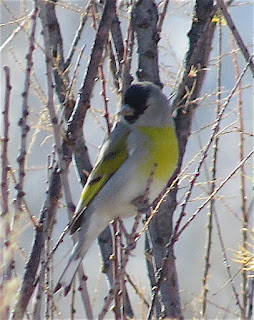


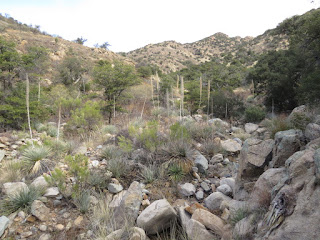

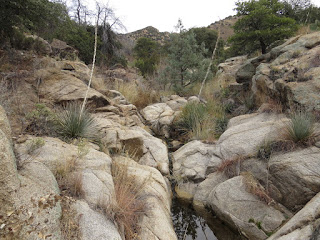

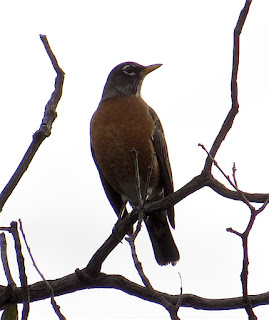



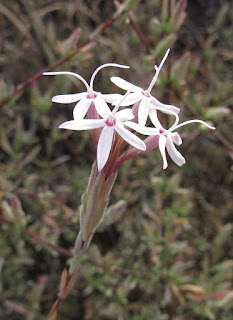
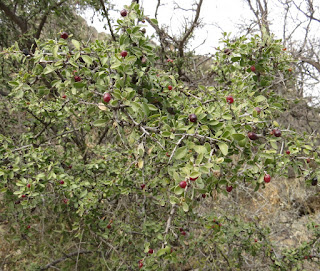





No comments:
Post a Comment